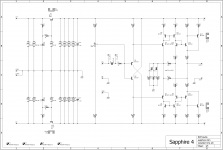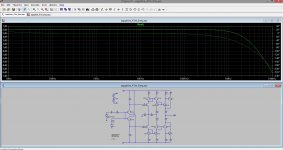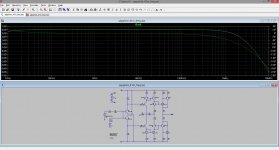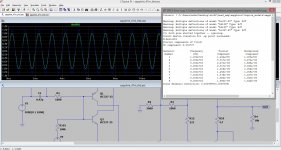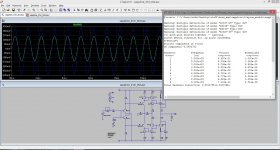Open loop or closed loop...what exactly do you mean??
I don't care about them being "ratty".
Personally, I don't need 27dB of gain for a line level source.
Can these be configured for say 2-4dB of gain?
I would be more interested in using them for a line stage/buffer application going into a power amp than for headphones.
Thanks.
I don't care about them being "ratty".
Personally, I don't need 27dB of gain for a line level source.
Can these be configured for say 2-4dB of gain?
I would be more interested in using them for a line stage/buffer application going into a power amp than for headphones.
Thanks.
And since I'm here a few more words about my listening impressions, as I've clocked up fair few hours since my last report.
So last night it struck me that I had forgotten over the last few days that I was listening to headphones, my HD-600's to be exact. I'd been reviewing my ripped CD collection, or just generally exploring Youtube, or even listening to vinyl - enjoying myself, naturally - but at some point whatever mental comparisons I was making stopped being with previous headphone amps and became just about the recordings themselves. I realized with something of a shock that this was because I could not discern that the sound was coming from headphones placed over my ears - I could only hear the music, spatially, as sound sourced in front and ahead of me - just like loudspeakers in other words. The headphones themselves appeared completely mute.
So I did the Keanu Reeves' "whoa..." thing for a spell and tried to make sense of what I was hearing. It seems my brain was processing the audio differently than before, effortlessly interpreting the stereo information as a fully 3-dimensional scene, a reality so convincing that I could not break the illusion even telling myself that physically, the sound must be coming from drivers pressed against each of my ears. Cue up a track and even with your eyes open, you are there experiencing the music as it unfolds in front of you.
So that's something of the what, but I'm still muddling out the why of it. Certainly there is simply more stuff to be heard. More details, more resolution, more clues for your brain to interpret venue ambiance and the individual players within that venue. I don't think that's the whole or even the main story though, as the amp is not what I would call a detail freak. You can hear whatever details you want to hear but never as to distract from the music. It's interesting what it does to ostensibly bad recordings: while the faults remains perfectly clear, and indeed more exposed than before, the performance - if it has any merit at all - sounds better than it ever did and the technical problems are soon forgotten for the enjoyment factor. For whatever reason everything sounds more immediate and realistic.
I continue to agonize about whether the circuit sounds so good because of what it adds, or because of what it doesn't add, to the signal. I can't answer that and I suspect, at the end, that is a little of the former together with a lot of the latter. But wow does it ever add up. I am - I continue to be - blown away by this amp.
So last night it struck me that I had forgotten over the last few days that I was listening to headphones, my HD-600's to be exact. I'd been reviewing my ripped CD collection, or just generally exploring Youtube, or even listening to vinyl - enjoying myself, naturally - but at some point whatever mental comparisons I was making stopped being with previous headphone amps and became just about the recordings themselves. I realized with something of a shock that this was because I could not discern that the sound was coming from headphones placed over my ears - I could only hear the music, spatially, as sound sourced in front and ahead of me - just like loudspeakers in other words. The headphones themselves appeared completely mute.
So I did the Keanu Reeves' "whoa..." thing for a spell and tried to make sense of what I was hearing. It seems my brain was processing the audio differently than before, effortlessly interpreting the stereo information as a fully 3-dimensional scene, a reality so convincing that I could not break the illusion even telling myself that physically, the sound must be coming from drivers pressed against each of my ears. Cue up a track and even with your eyes open, you are there experiencing the music as it unfolds in front of you.
So that's something of the what, but I'm still muddling out the why of it. Certainly there is simply more stuff to be heard. More details, more resolution, more clues for your brain to interpret venue ambiance and the individual players within that venue. I don't think that's the whole or even the main story though, as the amp is not what I would call a detail freak. You can hear whatever details you want to hear but never as to distract from the music. It's interesting what it does to ostensibly bad recordings: while the faults remains perfectly clear, and indeed more exposed than before, the performance - if it has any merit at all - sounds better than it ever did and the technical problems are soon forgotten for the enjoyment factor. For whatever reason everything sounds more immediate and realistic.
I continue to agonize about whether the circuit sounds so good because of what it adds, or because of what it doesn't add, to the signal. I can't answer that and I suspect, at the end, that is a little of the former together with a lot of the latter. But wow does it ever add up. I am - I continue to be - blown away by this amp.
Open loop or closed loop...what exactly do you mean??
I don't care about them being "ratty".
Personally, I don't need 27dB of gain for a line level source.
Can these be configured for say 2-4dB of gain?
I would be more interested in using them for a line stage/buffer application going into a power amp than for headphones.
Thanks.
Open loop the buffer is outside the feedback loop of the current feedback amplifier, closed loop it is placed inside. The connections for the 41m boards are made with R3 and R3X respectively, see attached.
The circuit can go down to 6 dB gain, and yes, it can be used as a line stage. R2 and R3 would need to be changed to different values.
Attachments
Stan, so are you implying the 4.0b version could very well be the "Holy Grail" and best sounding of Richard's "Sapphire" boards, or do you think there may still be room for SQ improvement in the 4.1m boards?
For someone who's been following this thread, it's certainly confusing since each newer version seems to be "better" than the previous version.
Thanks.
I haven't heard 4.1m ("closed loop") yet.
This is the curse of high-end audio: you've just heard something that surpasses everything that you'd heard up to that point. That becomes your new standard. Then somebody improves it.
I've built 2, 3 and 4. Sapphire 3 was indisputably improved over Sapphire 2; Sapphire 4.0b is indisputably improved over the early version of 3. I have not heard the later version of Sapphire 3 that was tweaked to accommodate discrete op amps. It's the missing link in my chain.
It was the exactly same as the Sapphire 3 with the IC, just with (optionally) a discrete op amp. The 995FET module added smoothness and overall refinement over the NE5534 or OPA134, but provided no revelations.
Open loop the buffer is outside the feedback loop of the current feedback amplifier, closed loop it is placed inside. The connections for the 41m boards are made with R3 and R3X respectively, see attached.
The circuit can go down to 6 dB gain, and yes, it can be used as a line stage. R2 and R3 would need to be changed to different values.
A few questions:
1) So use R3X for closed feedback loop or R3 for open feedback loop, but not both at the same time?
2) What is T+ and T- on the boards?
3) What values do you recommend for R2 and R3 for 6 dB of gain?
4) Can the boards you're selling be used open loop by removing the Dale resistor you have soldered across the board and reinstalling R3?
Thanks.
1) So use R3X for closed feedback loop or R3 for open feedback loop, but not both at the same time?
That's right.
2) What is T+ and T- on the boards?
T(est) pads. Provides a copy of the output OUT+ and OUT- for measuring the DC output offset. I removed them on the 41m board.
3) What values do you recommend for R2 and R3 for 6 dB of gain?
R2=4.75k R3=10k for open loop, R2=1k R3=1k for the closed loop configuration. I can set these resistors to whatever configuration you want before I send the boards.
4) Can the boards you're selling be used open loop by removing the Dale resistor you have soldered across the board and reinstalling R3?
Yes.
I've attached the BOM files for both versions below for your reference. The 41m BOM goes into the details of the closed loop gain calculations. For now both BOMs are also available on my web page under the Sapphire 4 section.
That's right.
2) What is T+ and T- on the boards?
T(est) pads. Provides a copy of the output OUT+ and OUT- for measuring the DC output offset. I removed them on the 41m board.
3) What values do you recommend for R2 and R3 for 6 dB of gain?
R2=4.75k R3=10k for open loop, R2=1k R3=1k for the closed loop configuration. I can set these resistors to whatever configuration you want before I send the boards.
4) Can the boards you're selling be used open loop by removing the Dale resistor you have soldered across the board and reinstalling R3?
Yes.
I've attached the BOM files for both versions below for your reference. The 41m BOM goes into the details of the closed loop gain calculations. For now both BOMs are also available on my web page under the Sapphire 4 section.
Attachments
Last edited:
having built and listened to for extended periods Richard's Sapphire since 14s1 up to 3xx i can say that each one has been an improvement is sound.
IIR there was a open/closed loop on the 14s1 boards.
now we have a mk4... tempting 🙂
IIR there was a open/closed loop on the 14s1 boards.
now we have a mk4... tempting 🙂
Hi Richard,
Could you let me know minimum requirements of transformer?
15VA for stereo. It's arbitrary to an extent, but that seems a reasonable limit.
Richard, looking over your 4.1m BOM, you state "The circuit also makes a nice preamplifier. If the resistors are changed to reduce the bias current the heatsinks are not needed. See BOM for details."
I looked at the BOM and didn't see anything mentioned about which resistors control the bias, just the resistors that control closed and open loop voltage gain highlighted in red.
So do R11 and R12 control the bias, or are there other resistors that control it?
What value resistors do you recommend to lower the bias so as to use this a preamp and eliminate the need for heatsinks?
I looked at the BOM and didn't see anything mentioned about which resistors control the bias, just the resistors that control closed and open loop voltage gain highlighted in red.
So do R11 and R12 control the bias, or are there other resistors that control it?
What value resistors do you recommend to lower the bias so as to use this a preamp and eliminate the need for heatsinks?
The adjustments to lower the bias current are detailed in notes to the right of the main parts list of the BOM worksheets. The parts are highlighted in blue.
Actually the ratio of R10,11 and R17,18 set the current, and it is R17,18 that is adjusted for the preamp version while R10,11 is tweaked if you want more\less current as a headphone amp.
Actually the ratio of R10,11 and R17,18 set the current, and it is R17,18 that is adjusted for the preamp version while R10,11 is tweaked if you want more\less current as a headphone amp.
Gotcha. I see the values listed in blue in column J now. I didn't go over far enough to the right to view those columns.
PM sent.
PM sent.
Chassis
RJM, am I dreaming or do I remember you making a chassis recommendation recently? The thread search tool didn't provide any clues, probably because I didn't ask the right question.
RJM, am I dreaming or do I remember you making a chassis recommendation recently? The thread search tool didn't provide any clues, probably because I didn't ask the right question.
I made some search and this enclosure (so-called 1907a) will perfectly fit. Little bit cheaper in aliexpress, much cheaper in taobao.
1907A Headphone Amplifier Chassis Full Aluminum Preamplifier Enclosure AMP Box | eBay
1907A Headphone Amplifier Chassis Full Aluminum Preamplifier Enclosure AMP Box | eBay
Yes, that's the one I've used in the past with good results.
There are plenty of similar options, pre-drilled or plain box, but make sure the internal width is at least 180 mm, with about 260 mm or more front to back. Otherwise things get cramped.
There's a ton of similar-looking chassis on ebay that are in fact smaller than the one withmatt linked. You don't want those.
There are plenty of similar options, pre-drilled or plain box, but make sure the internal width is at least 180 mm, with about 260 mm or more front to back. Otherwise things get cramped.
There's a ton of similar-looking chassis on ebay that are in fact smaller than the one withmatt linked. You don't want those.
Last edited:
Sapphire 4 THD
While waiting for boards to arrive, I drew up an LTSpice model of RJMs Sapphire 4. I spoke with RJM, and he's OK with me posting the screenshots of the simulations. They show the excellent performance possible with his circuit. As RJM pointed out, these are models which have noiseless voltage sources, perfectly matched transistors, and don't include effects of temperature, actual performance may not be as good. I think he is being modest.🙂
First screenshot shows a model of Sapphire 4 configured as a headphone amp (gain of 3, 26R load, what I plan for my boards). The simulation predicts overall THD of 0.0014%. Guys (and gals), that is 14 parts per million, -97dB down. The second harmonic is -97dB down, third harmonic -104dB, fourth and higher -140db. Excellent!
The second screenshot shows a line buffer configuration, gain of just over 1, 10K load, about what one could expect from an amplifier/preamp input. Simulated THD is 0.000465%, or -106dB. Even better.
Third screenshot shows frequency response and overall phase shift with the standard 0.47uF input coupling cap. The solid line is frequency, the dotted line phase. Note the ruler flat frequency response from about 30Hz to more than 200kHz. Tiniest bit of phase shift, about 10 deg at 20Hz, decreasing to zero around 120Hz. Very, very good.
In the fourth screenshot the input coupling cap was increased to 1uF. This shifted ruler-flat frequency response to 20Hz (or lower), and decreased phase shift to maybe 5% at 20Hz, again decreasing to zero around 120Hz. Even better. I'm not sure these changes would be audible. RJM points out that some headphones are bass heavy (agree), or that some may not prefer heavy bass bass like myself (agree), and the (tiny) roll-off might be preferred (agree).
Another observation is how load-tolerant this circuit is. Changing the load from 26R to 250R has an insignificant effect on THD. To me that implies this amp will match up well with just about any headphone.
And to those who have earlier boards, don't feel left out. I've been following this thread since inception, and my belief is that the basic circuitry is unchanged, which implies that both early and late boards have same performance. RJ can confirm.
Numbers aside, the real test is the listening test ,and I've read nothing but positive reports to date. Can't wait for my boards to arrive so I can give a listen too.
While waiting for boards to arrive, I drew up an LTSpice model of RJMs Sapphire 4. I spoke with RJM, and he's OK with me posting the screenshots of the simulations. They show the excellent performance possible with his circuit. As RJM pointed out, these are models which have noiseless voltage sources, perfectly matched transistors, and don't include effects of temperature, actual performance may not be as good. I think he is being modest.🙂
First screenshot shows a model of Sapphire 4 configured as a headphone amp (gain of 3, 26R load, what I plan for my boards). The simulation predicts overall THD of 0.0014%. Guys (and gals), that is 14 parts per million, -97dB down. The second harmonic is -97dB down, third harmonic -104dB, fourth and higher -140db. Excellent!
The second screenshot shows a line buffer configuration, gain of just over 1, 10K load, about what one could expect from an amplifier/preamp input. Simulated THD is 0.000465%, or -106dB. Even better.
Third screenshot shows frequency response and overall phase shift with the standard 0.47uF input coupling cap. The solid line is frequency, the dotted line phase. Note the ruler flat frequency response from about 30Hz to more than 200kHz. Tiniest bit of phase shift, about 10 deg at 20Hz, decreasing to zero around 120Hz. Very, very good.
In the fourth screenshot the input coupling cap was increased to 1uF. This shifted ruler-flat frequency response to 20Hz (or lower), and decreased phase shift to maybe 5% at 20Hz, again decreasing to zero around 120Hz. Even better. I'm not sure these changes would be audible. RJM points out that some headphones are bass heavy (agree), or that some may not prefer heavy bass bass like myself (agree), and the (tiny) roll-off might be preferred (agree).
Another observation is how load-tolerant this circuit is. Changing the load from 26R to 250R has an insignificant effect on THD. To me that implies this amp will match up well with just about any headphone.
And to those who have earlier boards, don't feel left out. I've been following this thread since inception, and my belief is that the basic circuitry is unchanged, which implies that both early and late boards have same performance. RJ can confirm.
Numbers aside, the real test is the listening test ,and I've read nothing but positive reports to date. Can't wait for my boards to arrive so I can give a listen too.
Attachments
Thanks Mike.
To reiterate publicly what I told you earlier: simulated distortion figures, while informative, are not something of intrinsic value. Think of it as a bar to clear, and so far as possible by tweaking the circuit values, optimize for.
Perhaps you can post the .asc file so people can do their own tests?
To address one thing: yes, Sapphire 3 has similar performance both simulated and measured, but it's not such a difficult challenge on my part since most of that performance originates from the op amp IC/module rather than the output stage.
To reiterate publicly what I told you earlier: simulated distortion figures, while informative, are not something of intrinsic value. Think of it as a bar to clear, and so far as possible by tweaking the circuit values, optimize for.
Perhaps you can post the .asc file so people can do their own tests?
To address one thing: yes, Sapphire 3 has similar performance both simulated and measured, but it's not such a difficult challenge on my part since most of that performance originates from the op amp IC/module rather than the output stage.
Last edited:
Sapphire 3 was very, very good, but with the jelly-bean op-amps it exhibits limits, as comments about the discrete op-amp in the later version of 3 attest, and Sapphire 4 demonstrates.
My Sapphire 4 build employs .68uF input coupling caps and the lower bass coming through my DT880's is marvellous: natural, clean, airy, and revealing recording space like nothing else I've heard.
My Sapphire 4 build employs .68uF input coupling caps and the lower bass coming through my DT880's is marvellous: natural, clean, airy, and revealing recording space like nothing else I've heard.
- Home
- Amplifiers
- Headphone Systems
- RJM Audio Sapphire Desktop Headphone Amplifier
